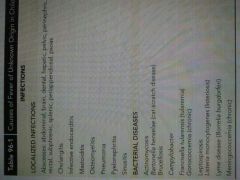![]()
![]()
![]()
Use LEFT and RIGHT arrow keys to navigate between flashcards;
Use UP and DOWN arrow keys to flip the card;
H to show hint;
A reads text to speech;
31 Cards in this Set
- Front
- Back
|
normal temp range
|
97 - 99.6 F
|
|
|
tetracycline
|
bacteriostatic
|
|
|
tetracycline
|
may be antagonistic when used with a beta lactam
|
|
|
older infants (> 1 mth) and children < 5 yrs
|
may have an exagggerated febrile response ...temp <= 105 F
WHICH could mean serious infections in children older than 5 |
|
|
fever of unknown origin
|

|
|
|
roseola infantum, sixth disease
|
caused by PRIMARILY by HHV-6
and HHV-7 in 10-30% |
|
|
hhv-6
|
major cause of acute febrile illness in infants
and may be responsible for 20~ OF ER visits for children 6-18 mths |
|
|
impetigo clincal presentation
|
vesicles or bullae -
most often involve face, most commonly around nares and mouth fever - uncommon |
|
|
impetigo tx
|
stay out of school/day care until 24 h antibiotic therapy
nonbullous - topical muciprocin 2nd line - antibiotics(oral) bullous - antibiotics(oral) |
|
|
cellulitis empirical tx
|
1st gen cephalosporin
if MRSA in community high then use clindamycin or cotrimoxazole |
|
|
strep pyogenes cause
|
cellulitis and erysipelas
|
|
|
hospitlaization for cellulitis is required:
|
for erysipelas and cellulitis of hands, feet, face, perineum, lymphangiitis and those failing outpatient tx
|
|
|
perianal dermatitis etiology
|
strep pyogenes
|
|
|
tx of herpes simplex in special population
|
infants
persons with eczema immunodeficiency should receive intravenous acyclovir |
|
|
lymph nodes in kids
|
most prominent in children 4-8 yrs old
|
|
|
EBV serology
|
most reliable test for acute ebv infection is IgM antiviral capsid antigen (I.e. esp in children less 4)
|
|
|
brudinksi and kerning sin are present in children
|
older than 1 year old
|
|
|
rare causes of rhinorrhea
|
choanal atresia or stenosis
csf fistula diphtheria tumor nasopharyngeal malignancy syphilis congenital (snuffles) Wegener Granulomatosis |
|
|
ddx for acute orbital cellulitis
|
aspergillosis
rhabdomyosarcoma neuroblastoma Wegener granulomatosis trinchinosis pseudotumor of orbit zygomycosis |
|
|
normal flora of external canal of ear
|
corynebacterium
coagulase negative staph aureus |
|
|
otitis externa presentation
|
fever absent and hearing unaffected
tenderness aural discharge |
|
|
malignant otitis externa
|
same symptoms as o externa PLUS facial nerve palsy
|
|
|
fluoroquinolones
|
contraindicated in <18 mths
plus preg and lactating women |
|
|
tetracycline
|
contraindicated in <9 yrs
|
|
|
sterile vegetation s
endocarditis |
rheumatic heart disease
lupus |
|
|
osteomyelitis
|
most common in children 3-10
more common in boys |
|
|
infectious arthritis aka
|
suppurative or septic
|
|
|
children with TB
|
rarely infect other children and adults
|
|
|
TB
|
significant cough is absent
|
|
|
hospitalized tb children
|
are respiratory isolation
most recover in 2 wks on tx and non infectious in several days |
|
|
tb disease
|
clinical ftx
or abnormal xray |

